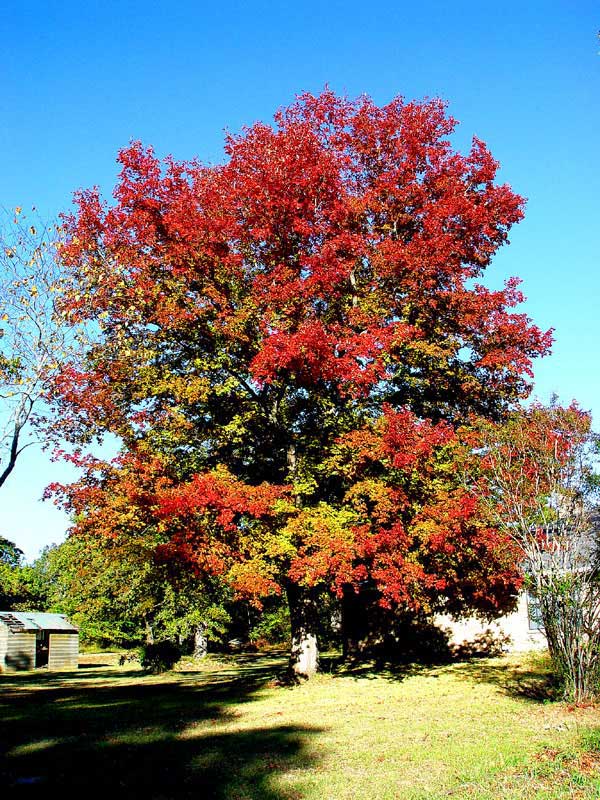RiskVA
The Magic of Autumn 9 Nov 2005
Autumn officially begins the third week of September. But I never believe it until the humidity and temperatures drop, summer haze departs, katydids and locusts cease their frenzied chirping and singing, the hummingbirds head south, and leaves start changing color. And this year, fall’s arrival was overshadowed by Hurricane Rita’s approaching landfall in the East Texas Gulf area.
Every year as fall begins, the star cluster call the Pleiades, or Seven Sisters, appears above the eastern horizon. Currently, by ten o’clock in the evening, this constellation is high in the sky and a reclining Orion, the Hunter is rising over the trees, warning us that winter will begin in about six weeks.
Planets cannot be depended on as annual indicators of changing seasons. But this fall, Mars and Venus are both spectacular additions to the evening sky. After sunset Venus gleams brilliantly white in the southwest, the brightest celestial object in that part of the sky. High in the east, Mars, closer to the earth than it has been for many years, shines spectacularly orange-yellow, even brighter than Venus. A moderate telescope will allow you to see some of its land features even though there is a spectacular dust storm under way there now.
Fall colors are dead giveaways of seasonal change. For some time now, tree leaves have been yellowing. Orange and red are beginning to flame in fields and forests of East Texas. Those colors have been there all along, but were hidden by the green of chlorophyll. Vital to plant life, and critical for us too, chlorophyll, when exposed to sunlight, allows green plants to make their own food from carbon dioxide and water and also produce oxygen.
Nature’s alarm clocks tell trees it’s color time, not cold weather or frost. In fact, freezing temperatures can quickly destroy fall colors. Trees, like most living things, have built-in biologic timers that keep track of day length. When the number of hours of light drops to a critical point, trees stop producing chlorophyll, shutting down their food manufacturing plant. As the chlorophyll fades, the yellow and orange of carotenoids, the same substances that color carrots, banana skins and sunflowers, begin to show through. Xanthophylls show up as tan and brown while anthocyanins, formed from trapped sugar in the leaves add red, blue and purple. These colors combine to give us the wide spectrum of autumn colors.
Every tree and shrub has its own characteristic fall leaf color. Sassafras is gold while sumac and dogwood, along with sweet gum, glow brilliant red. As the season progresses, maples and oaks of many kinds will turn yellow, red and crimson. Even poison ivy contributes to fall decorating, turning bright red, but be advised that it can still cause a serious rash, even at this time of the year.
Color change comes in waves, first yellow, next orange and last red, with each new spectral burst separated from the next by five days to two weeks. Depending on weather and location, we should have nice leaf color through Thanksgiving. Sunny, cool, dry days produce the best show while cloudy, drizzly weather and warm days usually mean a disappointing color season.
The East Texas Guide located at www.easttexasguide.com on the Web is a great place to find information on the development of fall color and get information about scenic foliage drives along with many other autumn oriented activities.
Meteor showers are also part of the late fall outdoor experience. The Taurid Meteor Shower has been in progress for some time and will continue into December. It is named because the meteors seem to originate in the constellation Taurus. On several recent nights observers in some places have even seen large fireballs streaking across the sky as pieces of celestial material burn up in the atmosphere.
From the 14th through the 21st of this month another meteor show called the Leonid Meteor Shower will occur. This year, a major outburst of activity is not expected, but you may still see as many as 20 meteors per hour during the Leonid peak about the 19th. The best viewing to the east after midnight.
In short, fall is a wonderful season. Changes are taking place in the weather, the sky, the fields and forests. Nature seems to be gearing down; relaxing a bit. Evenings are cool and lazy crickets, their chirping slowed by falling temperatures, languidly announce a changing of the guard. It’s fall folks. Get out and enjoy it.
Dr. Risk is a professor emeritus in the College of Forestry and Agriculture at Stephen F. Austin State University in Nacogdoches, Texas. Content © Paul H. Risk, Ph.D. All rights reserved, except where otherwise noted. Click paulrisk2@gmail.com to send questions, comments, or request permission for use.

